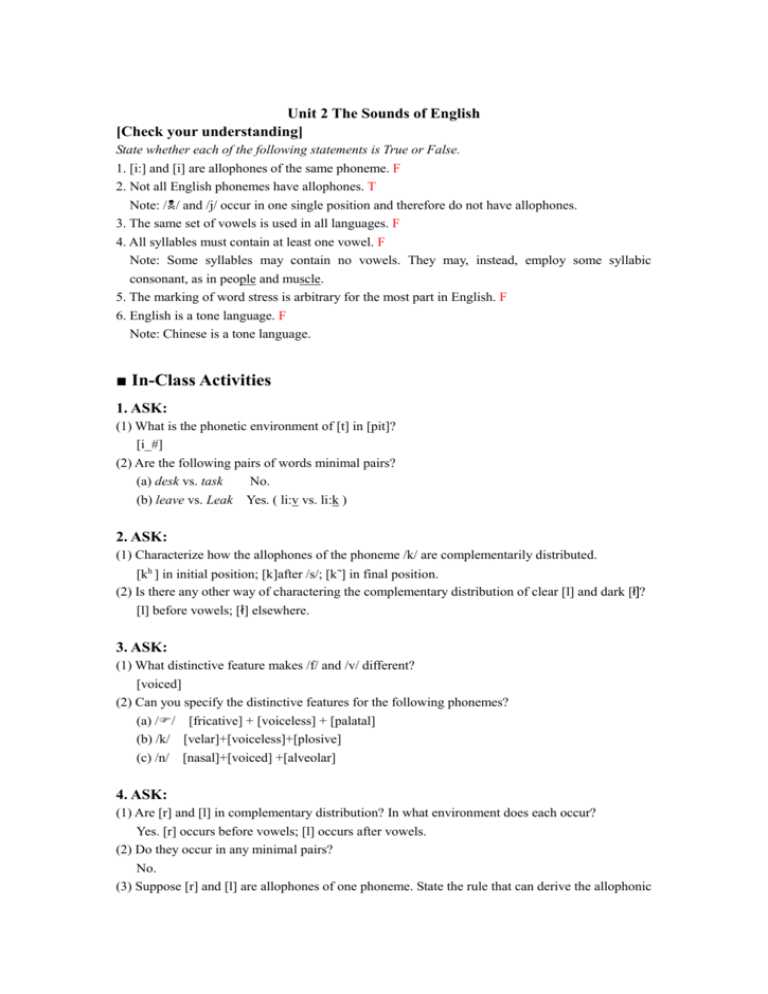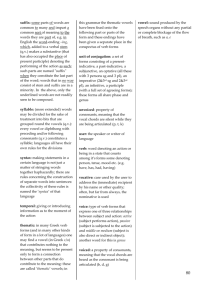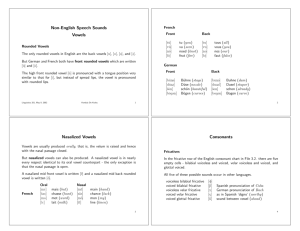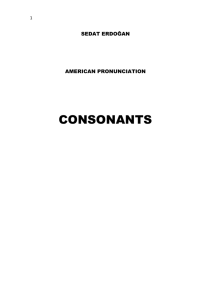20091110213313485
advertisement

Unit 2 The Sounds of English [Check your understanding] State whether each of the following statements is True or False. 1. [i:] and [i] are allophones of the same phoneme. F 2. Not all English phonemes have allophones. T Note: // and /j/ occur in one single position and therefore do not have allophones. 3. The same set of vowels is used in all languages. F 4. All syllables must contain at least one vowel. F Note: Some syllables may contain no vowels. They may, instead, employ some syllabic consonant, as in people and muscle. 5. The marking of word stress is arbitrary for the most part in English. F 6. English is a tone language. F Note: Chinese is a tone language. ■ In-Class Activities 1. ASK: (1) What is the phonetic environment of [t] in [pit]? [i_#] (2) Are the following pairs of words minimal pairs? (a) desk vs. task No. (b) leave vs. Leak Yes. ( li:v vs. li:k ) 2. ASK: (1) Characterize how the allophones of the phoneme /k/ are complementarily distributed. [kh ] in initial position; [k]after /s/; [k¬] in final position. (2) Is there any other way of charactering the complementary distribution of clear [l] and dark [ł]? [l] before vowels; [ł] elsewhere. 3. ASK: (1) What distinctive feature makes /f/ and /v/ different? [voiced] (2) Can you specify the distinctive features for the following phonemes? (a) // [fricative] + [voiceless] + [palatal] (b) /k/ [velar]+[voiceless]+[plosive] (c) /n/ [nasal]+[voiced] +[alveolar] 4. ASK: (1) Are [r] and [l] in complementary distribution? In what environment does each occur? Yes. [r] occurs before vowels; [l] occurs after vowels. (2) Do they occur in any minimal pairs? No. (3) Suppose [r] and [l] are allophones of one phoneme. State the rule that can derive the allophonic forms. [r] is lateralized when it occurs after vowels. 5. ASK: (1) Can you give more examples of assimilation? compatriot, sing (2) Can you find any exceptions? input, unbeatable, Canberra (3) What phonetic segments condition this change? The consonant immediately after the vowel. [Note] 2) [tai] should be [tay]. 6. ASK: (1) Can you give more examples of free variation? advertisement [əd΄və:tismənt] [əd΄və:tizmənt] association [əsəusi΄eiən] [əsəui΄eiən] (2) Why do you think such a phenomenon exists in a language like English? Individual variation is responsible for this phenomenon. 7. ASK: (1) Which sound is deleted in “sign”, “design”, and “resign”? [g] (2) Can you offer other examples of deletion? paradigm (atic), condemn(ation) (3) Can you give some words that involve total deletion? plumb, plumber; climb, climbing (4) Are there any other types of deletion in English? debt, know 8. ASK: (1) Can you think of a phonetic description of the regular pattern in these expressions? They all start with a front, high vowel and follow up with a mid or low vowel. (2) Can you think of any possible explanation for the observed pattern? [i] involves the least degree of mouth opening while the mid or low vowels necessitate bigger opening. There is an increase of mouth opening in pronouncing the whole word, which is symbolic in meaning. 9. ASK: (1) What are likely positive effects of using alliteration? Use one of the poetic examples to illustrate. Coherence, connectedness, smoothness, consistency. Take “I slip, I slide, I gloom, I glance” for example. The double alliteration involved helps to create a picture of smooth and coherent dance. (2) Is there a similar use of alliteration in Chinese? Yes, though less often. 花好月圆 is a good example. 10. ASK: (1) What is the stylistic effect of rhyming? echoing, agreement, correspondence, etc. (2) Can you find more proverbs that involve internal rhyming? First thrive and then wive. Fancy passes beauty. ■ Exercises Task 3: Study Questions 1. a. Does the string of sounds mean anything to you? If we want to talk really good, we’ll have to invent vowels. b. What does the picture suggest to you about the role of consonants and vowels in English? Consonants are the backbones of syllables and words. 2. Some phonetic transcriptions below are English words, some are not existing words but are possible words or nonsense words, and others are definitely “foreign” or impossible because they violate English sequential constraints. Specify each of the a-e cases as illustrated. Word Possible Foreign Reason Example: [pa:k] [tif] [lkib] a. [ŋa:f] b. [ski:] [] must occur after a vowel. ski c.[knait] d.[meij] e.[blaft] [] must occur initially before a vowel. 3. In English, the /i/ vowel becomes almost as long as /i:/ under certain conditions (written as /i:/ for convenience). Consider the examples listed below: a. List the phonemes that condition the change. voiced consonants b. State the rule that seems involved. [i] is lengthened before a voiced] consonant. Note: Start with the fact that the /i/ is basic and that short /i/ becomes long /i:/. The change from short /i/ to long /i:/ is phonologically determined; that is, the lengthening takes place in the presence of certain phonemes. A good strategy is to first list the phonemes to the right of long /i:/, then list those to the left. As an answer to (a), then, one would propose that /i/ become /i:/ whenever the phonemes to the right (/d, m, l, b, z, j, ŋ/) occur immediately after that vowel. This hypothesis looks promising because, in fact, the short variant /i/ never occurs before these segments. The next question is, what is it about the phonemes on the right that unify them as a class? One may find that these phonemes are all voiced ([+voice]), and, in fact, the short /i/ never lengthens before voiceless segments. Thus the answer to (b) is that the vowel /i/ is lengthened before (the natural class of) voiced consonants. 4. The use of plural –s in English has three different, but very regular, phonological alternatives. a. Can you work out the set of sounds which regularly precedes each of these alternatives? /s/ to words like ship, bat, book and cough; voiceless plosives [voiceless] /z/ to words like cab, lad, cave, rag and thing; after voiced consonants [voiced] /əz/ to words like bus, bush, judge, church and maze. after /s/, //, /d/, /z/ b. What features does each of these sets have in common? [palatal] or [alveolar]+[fricative] c. Is there any pattern regarding the different pronunciations of the past tense marker? [t] after voiceless consonants except [t]; [d] after voiced consonants except [d]; [id] after [t] or [d]. d. Do you think that one of these phonological forms for –ed is more basic, with the others being derived from it in a regular way? Which, and how? [d] is more basic. [t] after devoicing. [id] after epenthesis (i.e. addition of a sound). 5. Below are three columns of words with different patterns of stress: a. How is stress distributed in each column? penultimate for A; last syllable for B; on the last syllable. b. In Column B, what kinds of vowels appear in the last syllable? How does the syllabic structure of Column C differ from A and B? In Column B, long vowels or diphthongs appear in the last syllable. The last syllable of the words in C ends in consonant clusters. [Note] For “usurp”, “r” may be pronounced as in /ju(:)΄zə(r)p/. 6. The following is a list of words that are spelt in a similar way: fuddy-duddy hocus-pocus namby-pamby fuzzy-wuzzy hurly-burly razzle-dazzle hanky-panky lovey-dovey roly-poly helter-skelter mumbo-jumbo super-duper a. What similarity can you spot among the words listed? All pairs are the same except the initial consonants. b. What effects may such words have in common when they are put into use? Redundancy, repetitiveness, etc. 7. Write the phonetic transcription for each of the following words. Omit. 8. Read the following words or phrases and point out the phonological processes that yield assimilation. (a) pat /pæt/ pan /pãn/ sat /sæt/ Sam /sãm/ Nasalization rule: [-nasal] [+nasal] /_____ [+nasal] (b) since /sins/ sink /siŋk/ hint /hint/ dink /diŋk/ Velarization rule: [-velarl] [+velar] /_____ [+velar] (c) five pits /faifpits/ love to /lftə / Devoicing rule: [+voiced [-voiceless] /_____ [-voiceless] 9. a. Comment on the use of rhyme, alliteration, and assonance (that is, use of syllables with a common vowel, as in “come” - “love”) in this poem. How are they used to stress the sense of superficiality and lack of meaning the poet is trying to convey here? (Note especially the role of rhyming pairs of monosyllables and their effect on meter.) assonance: [ri:t] [skri:n] [spi:t] [ud] [huk] [buk] The ryhmed words, all monosyllabic and stressed, are semantically unrelated and separated. Alliteration is only sporadically used. Assonance suggests apparent connection but actual disconnectedness. b. Comment more carefully on meter in the first two stanzas. How does it contribute to the meaning? How and where does it work against our expectations? Lack of regularity and thus unpredictability. 10. Collect some data to show that English advertisements, newspaper headlines, English songs, and presidential addressee sometimes make use of alliteration and rhyming. Omit. 11. What interesting things do speech errors tell us about language and its use? Collect a few cases of slips of tongue from daily conversations. Speech errors are often explainable, often semantically motivated.







